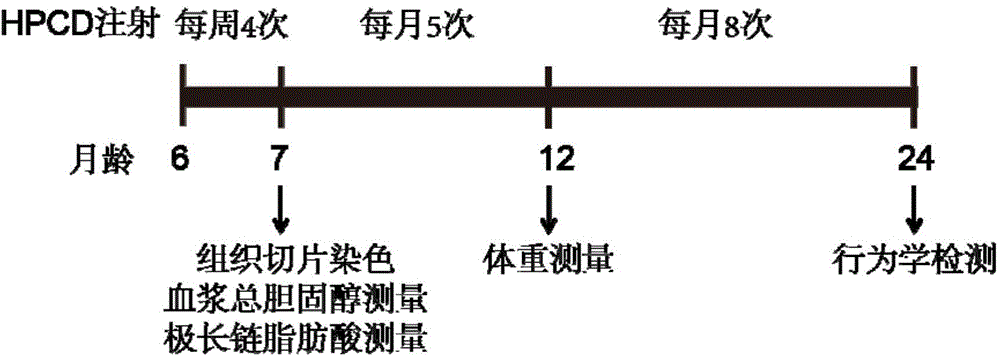Application of 2-hydroxypropyl-beta-cyclodextrin to the preparation of drug for treatment of X-linked adrenoleukodystrophy
A cyclodextrin, adrenal brain technology, applied in the field of biomedicine, can solve the problems of staying, infeasible, unable to improve X-ALD brain lesions and behavioral abnormalities, so as to reduce the level of VLCFA and alleviate the symptoms of behavioral abnormalities. Effect
- Summary
- Abstract
- Description
- Claims
- Application Information
AI Technical Summary
Problems solved by technology
Method used
Image
Examples
Embodiment 1
[0021] Embodiment 1 HPCD injects X-ALD mouse procedure
[0022] Materials used in this example: 2-hydroxypropyl-β-cyclodextrin (2-hydroxypropyl-β-cyclodextrin) HPCD was purchased from Cyclodextrin Technologies Development, Inc., and ABCD1 knockout mice were purchased from Jackson Laboratory.
[0023] according to figure 1 The indicated procedures are effective for wild-type (WT) and X-ALD model mice (ABCD1 knockout mice, ABCD1 - / - Mice) were injected with HPCD at the back of the neck, and the injection dose was 4000 mg HPCD per kg of mouse body weight, specifically as follows: prepare 20% HPCD (W / V) with 0.9% normal saline, and inject 4 weeks of mice from 6 months to 7 months of age 20% HPCD once, the control group was injected with the same volume of normal saline, and Filipin staining of cells, Filipin staining of adrenal gland and cerebellar tissue sections, and measurement of plasma total cholesterol and very long-chain fatty acids were performed at the age of 7 months; ...
Embodiment 2
[0024] Example 2 HPCD alleviates intracellular cholesterol accumulation in X-ALD mice
[0025] Materials used in this example: Filipin was purchased from Sigma.
[0026] In order to detect whether HPCD can improve the symptoms of cholesterol accumulation at the cellular level of X-ALD mice, the 7-month-old WT, ABCD1 - / - In mice, the tail tip fibroblasts were isolated and cultured for Filipin staining observation.
[0027] Filipin staining: the isolated and cultured tail tip fibroblasts were fixed with 4% paraformaldehyde at room temperature for 30 min; washed twice with PBS; diluted ethanol-dissolved Filipin mother solution (5 mg / mL) with PBS containing 10% fetal bovine serum (FBS) to The final concentration was 50 μg / mL, and incubated at room temperature in the dark for 30 minutes; washed three times with PBS and twice with deionized water; sealed, dried overnight, observed under a laser confocal microscope, and stored at -20°C.
[0028] Filipin staining results are as foll...
Embodiment 3
[0029] Example 3 HPCD alleviates tissue cholesterol accumulation in X-ALD mice, reduces plasma total cholesterol and very long-chain fatty acids (VLCFA)
[0030] To test whether HPCD can improve the symptoms of cholesterol accumulation at the tissue level in X-ALD mice, and reduce plasma total cholesterol and very long-chain fatty acids (VLCFA). Get the 7-month-old WT, ABCD1 injected with normal saline and HPCD respectively in Example 1 - / - In mice, the adrenal gland and cerebellum were isolated for frozen section and Filipin staining, and plasma total cholesterol and very long-chain fatty acids were measured.
[0031](1) Staining of tissue sections: cut open the thorax of the mouse after anesthesia, insert a 20mL syringe connected to the scalp needle through the left ventricle, cut a small mouth at the right atrial appendage with scissors, push in 20mL of normal saline, and quickly change to 20mL after pushing 4% paraformaldehyde; take out the adrenal gland and cerebellum, a...
PUM
 Login to View More
Login to View More Abstract
Description
Claims
Application Information
 Login to View More
Login to View More - R&D
- Intellectual Property
- Life Sciences
- Materials
- Tech Scout
- Unparalleled Data Quality
- Higher Quality Content
- 60% Fewer Hallucinations
Browse by: Latest US Patents, China's latest patents, Technical Efficacy Thesaurus, Application Domain, Technology Topic, Popular Technical Reports.
© 2025 PatSnap. All rights reserved.Legal|Privacy policy|Modern Slavery Act Transparency Statement|Sitemap|About US| Contact US: help@patsnap.com



